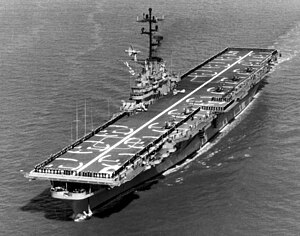
Back USS Princeton (CV-37) Czech Princeton (Schiff, 1945) German USS Princeton (CV-37) Spanish یواساس پرینستون (سیوی-۳۷) FA USS Princeton (CV-37) French USS Princeton (CV-37) Croatian USS Princeton (CV-37) ID USS Princeton (CV-37) Italian プリンストン (CV-37) Japanese USS Princeton (CV-37) Polish
 USS Princeton underway in 1965
| |
| History | |
|---|---|
| Name | Princeton |
| Namesake | Battle of Princeton |
| Builder | Philadelphia Naval Shipyard |
| Laid down | 14 September 1943 |
| Launched | 8 July 1945 |
| Commissioned | 18 November 1945 |
| Decommissioned | 21 June 1949 |
| Recommissioned | 28 August 1950 |
| Decommissioned | 30 January 1970 |
| Reclassified |
|
| Stricken | 30 January 1970 |
| Fate | Scrapped, September 1972 |
| General characteristics | |
| Class and type | Essex-class aircraft carrier |
| Displacement | 27,100 long tons (27,500 t) standard |
| Length | 888 feet (271 m) overall |
| Beam | 93 feet (28 m) |
| Draft | 28 feet 7 inches (8.71 m) |
| Installed power |
|
| Propulsion |
|
| Speed | 33 knots (61 km/h; 38 mph) |
| Complement | 3448 officers and enlisted |
| Armament | |
| Armor |
|
| Aircraft carried | 90–100 aircraft |
USS Princeton (CV/CVA/CVS-37, LPH-5) was one of 24 Essex-class aircraft carriers built during and shortly after World War II for the United States Navy. The ship was the fifth US Navy ship to bear the name, and was named for the Revolutionary War Battle of Princeton. Princeton was commissioned in November 1945, too late to serve in World War II, but saw extensive service in the Korean War, in which she earned eight battle stars, and the Vietnam War. She was reclassified in the early 1950s as an attack carrier (CVA), then as an Antisubmarine Aircraft Carrier (CVS), and finally as an amphibious assault ship (LPH), carrying helicopters and marines. One of her last missions was to serve as the prime recovery ship for the Apollo 10 space mission.
Although she was extensively modified internally as part of her conversion to an LPH, external modifications were minor, so throughout her career Princeton retained the classic appearance of a World War II Essex-class ship. She was decommissioned in 1970, and sold for scrap in September 1972.